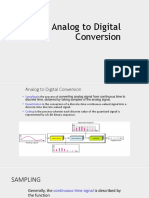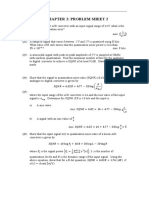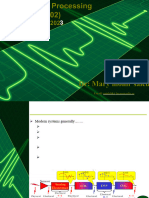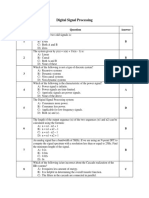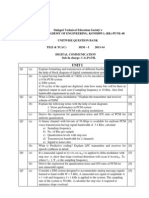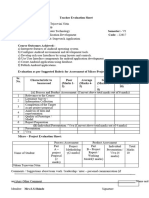Tutorial 1
Uploaded by
张琳Tutorial 1
Uploaded by
张琳ELEC9721: Digital Signal Processing Theory and
Applications
Tutorial 1
Q1.A discrete – time signal x[n] is defined by
1 0 n 9
x[n]
0 otherwise
Using u[n], describe x[n] as the superposition of two step functions.
Q2.Sketch the following:
a) x(t) = u(t-3) – u(t-5)
b) y[n] = u[n+3] – u[n-10]
c) x(t) = e2tu(-t)
d) y[n] = u[-n]
e) x[n] = [n] + 2[n-1] -[n-3]
f) h[n] = 2[n+1] + 2[n-1]
g) h[n] = u[n], p[n] = h[-n]; q[n] = h[-1-n], r[n] = h[1-n]
h) x[n] = n, <1
P[n} = n u[n], q[n] = nu[-n]
i) x(t) = e-3t[u(t) – u(t-2)]
Q3.
a) Consider a discrete-time sequence
x[n] cosn
8 5
Determine the fundamental period of x[n].
b)
i) Consider the sinusoidal signal
x(t) = 10 sin(t) =2fa
fa -analogue frequency and t- time,
fs -sampling frequency
Write an equation for the discrete time signal x[n]
If fa = 200 Hz and fs = 8, determine the fundamental period of x[n].
Q4) For a linear 16 bit A/D converter with an input signal range of ±4V, what is the
minimum quantisation error?
Q5) A sampled signal that varies between -2V and 2V is quantised using B bits. What value
of B will ensure that the quantisation noise power is less than 25 × 10−6 ?
Q6) A sinusoidal signal with peak-to-peak amplitude of 5V is sampled at 50kHz with
uniform quantisation. Find the minimum number of bits for the analogue to digital
converter to achieve a SQNR of at least 92dB. State any assumptions made.
Q7) Show that the signal to quantisation noise ratio (SQNR) of a linear B-bit analogue-to-
digital converter is given by
A
𝑆𝑄𝑁𝑅 = 6.02𝐵 + 4.77 − 20 log ( )
σsig
where the input range of the A/D converter is ±A and the rms value of the input signal
is 𝜎𝑠𝑖𝑔 . Determine the SQNR if B is 16 bits and the input is
a) A sine wave
𝐴
b) A signal with an rms value of 5
Q8) Show that the input signal x(t) to quantisation noise ratio of a linear A/D converter is
given by
𝑆𝑄𝑁𝑅 = 10 log 𝑃𝑠 + 10.8 + 20 log 𝐿 − 20 log 𝑅
1
where 𝑃𝑠 is the signal power [𝑃𝑠 = 𝑁 ∑𝑁−1 2
𝑛=0 𝑥 [𝑛]]; 𝐿 is the number of quantisation
levels and 𝑅 is the dynamic range of the input signal. Using the above equation, show
that for a B-bit quantiser, 𝑆𝑄𝑁𝑅 = 6.02𝐵 + 1.76 (𝑑𝐵) if 𝑥(𝑡) = 𝐴 cos(2𝜋𝑓𝑡)
You might also like
- Digital Signal Processing: Lecture 3 - 4No ratings yetDigital Signal Processing: Lecture 3 - 435 pages
- Analog Signal Processing Tutorial 2: Sampling and ReconstructionNo ratings yetAnalog Signal Processing Tutorial 2: Sampling and Reconstruction12 pages
- Introduction To The Simulation of Signals and Systems: Please Turn The Page OverNo ratings yetIntroduction To The Simulation of Signals and Systems: Please Turn The Page Over5 pages
- Sigspectra Assignment 2 (Sgueco Ece-302)No ratings yetSigspectra Assignment 2 (Sgueco Ece-302)6 pages
- Classifications of Signals: ECE 593: Signal, Spectra and Signal Processing Course OutlineNo ratings yetClassifications of Signals: ECE 593: Signal, Spectra and Signal Processing Course Outline6 pages
- Ecb3113, Edb2073 - Digital Signal ProcessingNo ratings yetEcb3113, Edb2073 - Digital Signal Processing10 pages
- Final Examination January: 2013 SemesterNo ratings yetFinal Examination January: 2013 Semester6 pages
- Digital Signal Processing & Applications: Subject Code - ECN-312No ratings yetDigital Signal Processing & Applications: Subject Code - ECN-31224 pages
- 541 39 Solutions-Instructor-manual Chapter 2No ratings yet541 39 Solutions-Instructor-manual Chapter 27 pages
- 2p6 2013 14 Communications Examples Paper 8No ratings yet2p6 2013 14 Communications Examples Paper 84 pages
- Digital Signal and Image Processing using MATLAB, Volume 3: Advances and Applications, The Stochastic CaseFrom EverandDigital Signal and Image Processing using MATLAB, Volume 3: Advances and Applications, The Stochastic Case3/5 (1)
- (PDF) 8.1.4.6 Lab - Calculating IPv4 SubnetsNo ratings yet(PDF) 8.1.4.6 Lab - Calculating IPv4 Subnets4 pages
- Time Table For Summer 2024 Theory ExaminationNo ratings yetTime Table For Summer 2024 Theory Examination10 pages
- Kubernetes Networks Solutions Comparison - Objectif LibreNo ratings yetKubernetes Networks Solutions Comparison - Objectif Libre20 pages
- Lect 4 Cryptographic System Trust ModelNo ratings yetLect 4 Cryptographic System Trust Model15 pages
- COMPUTER STUDIES FORM 3 SCHEMES OF WORKNo ratings yetCOMPUTER STUDIES FORM 3 SCHEMES OF WORK32 pages
- CS001-Computer Proficiency License: Solved MCQ (S) BY ArslanNo ratings yetCS001-Computer Proficiency License: Solved MCQ (S) BY Arslan17 pages
- Time Table For Summer 2024 Theory Examination 1No ratings yetTime Table For Summer 2024 Theory Examination 18 pages
- 103-Huawei OceanStor Distributed Storage V1.2No ratings yet103-Huawei OceanStor Distributed Storage V1.242 pages
- Linux and Shell Programming Practical File B.E V SemesterNo ratings yetLinux and Shell Programming Practical File B.E V Semester20 pages
- Sap Cloud Application Programming Model CapmNo ratings yetSap Cloud Application Programming Model Capm9 pages
- The History of Internet Explorer by Scott SchnollNo ratings yetThe History of Internet Explorer by Scott Schnoll6 pages

